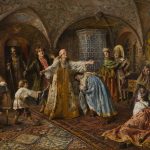Russian art boasts a rich and diverse heritage, spanning centuries of cultural, political, and social upheaval. From the grandeur of Orthodox icons to the avant-garde experimentation of the early 20th century, Russian painters have left an indelible mark on the world of art, creating masterpieces that continue to captivate and inspire audiences around the globe. In this article, we embark on a journey through some of the most famous Russian paintings, exploring their themes, techniques, and enduring significance in the annals of art history.
- “Morning in a Pine Forest” by Ivan Shishkin and Konstantin Savitsky:
One of the most beloved paintings in Russian art history, “Morning in a Pine Forest” captures the tranquil beauty of the Russian wilderness with breathtaking clarity and precision. Painted by Ivan Shishkin, one of Russia’s foremost landscape painters, in collaboration with his student Konstantin Savitsky, the painting depicts a family of bears emerging from their den in a sun-dappled pine forest.
What sets “Morning in a Pine Forest” apart is its remarkable attention to detail and exquisite rendering of light and shadow. Shishkin’s meticulous brushwork brings the lush foliage and majestic trees to life, while Savitsky’s skillful handling of color and texture imbues the bears with a sense of warmth and vitality. The painting evokes a sense of wonder and reverence for the natural world, inviting viewers to lose themselves in the serene beauty of the Russian countryside.
- “The Last Day of Pompeii” by Karl Bryullov:
Inspired by the tragic events of the eruption of Mount Vesuvius in 79 AD, “The Last Day of Pompeii” is a monumental historical painting by Russian artist Karl Bryullov. Completed in 1833, the painting depicts a scene of chaos and devastation as the ancient city of Pompeii is consumed by fire, ash, and molten lava.
Bryullov’s epic canvas is a tour de force of dramatic storytelling and technical virtuosity, with its sweeping panoramas, dynamic composition, and meticulously rendered figures. The painting captures the terror and despair of the doomed inhabitants of Pompeii, frozen in time as they face the cataclysmic forces of nature. “The Last Day of Pompeii” is a testament to Bryullov’s skill as a narrative painter and his ability to evoke powerful emotions in the viewer.
- “The Rooks Have Come Back” by Alexei Savrasov:
A quintessential example of Russian landscape painting, “The Rooks Have Come Back” by Alexei Savrasov is a lyrical evocation of the Russian countryside in springtime. Painted in 1871, the work depicts a flock of rooks returning to their nests against the backdrop of a golden sunset, signaling the arrival of warmer weather and the renewal of life.
Savrasov’s painting is notable for its poetic simplicity and emotional depth, with its muted color palette and soft, atmospheric lighting conveying a sense of quiet contemplation and serenity. “The Rooks Have Come Back” captures the timeless beauty of the Russian landscape and the cyclical rhythms of nature, inviting viewers to pause and reflect on the fleeting moments of beauty that surround us.
- “Reply of the Zaporozhian Cossacks” by Ilya Repin:
A masterpiece of historical painting, “Reply of the Zaporozhian Cossacks” by Ilya Repin is a vivid depiction of an episode from Ukrainian history in the 17th century. The painting portrays a group of defiant Cossacks composing a mocking and profane letter to Sultan Mehmed IV of the Ottoman Empire, in response to his demand for their surrender.
Repin’s painting is celebrated for its richly detailed composition, dynamic brushwork, and expressive characterization, with each figure imbued with a distinct personality and emotion. The painting captures the spirit of resistance and defiance that characterized the Cossack ethos, as well as the enduring struggle for freedom and independence in the face of tyranny.
These famous Russian paintings represent just a small sampling of the rich artistic heritage of Russia, a country that has produced some of the greatest painters in the history of art. From the sublime landscapes of Shishkin and Savrasov to the epic narratives of Bryullov and Repin, Russian paintings continue to captivate and inspire audiences with their beauty, depth, and emotional resonance. As we contemplate these masterpieces, we are reminded of the power of art to transcend time and space, touching the human soul and enriching our understanding of the world around us.



